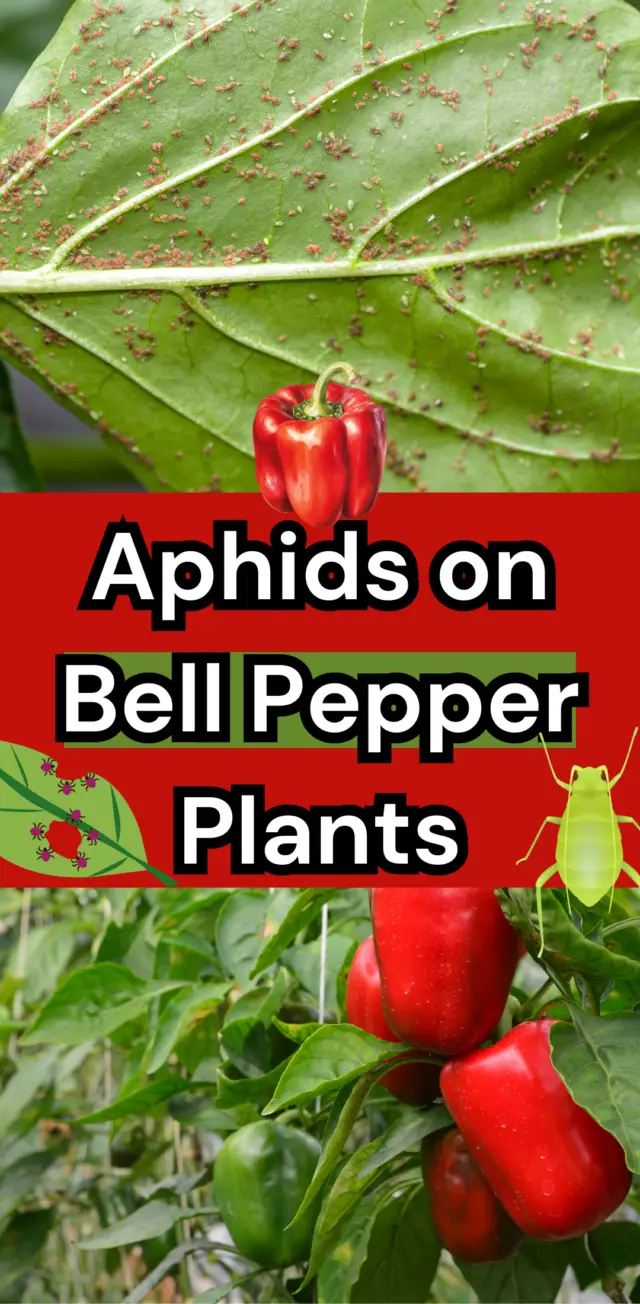As a passionate gardener, there’s nothing quite like watching your bell pepper plants thrive and produce an abundant harvest of juicy, flavorful fruits.
However, one of the most common pests that can wreak havoc on your bell pepper crop is the aphid. These tiny, soft-bodied insects can quickly infest your plants, sapping their strength and stunting their growth.
In this comprehensive blog post, we’ll dive deep into the world of aphids on bell pepper plants.
You’ll learn how to identify these pests, understand their life cycle, and discover effective strategies for preventing and controlling aphid infestations.
By the end, you’ll be equipped with the knowledge and tools to keep your bell pepper plants healthy and aphid-free all season.

Aphids on Bell Pepper Plants
Aphids, also known as “plant lice,” are small, sap-sucking insects that can infest a wide variety of plants, including bell peppers.
These tiny pests come in a range of colors, including green, black, red, and yellow, and they often cluster together on the undersides of leaves, stems, and flower buds.
Aphids feed by inserting their slender, piercing-sucking mouthparts into the plant’s tissues and extracting the nutrient-rich sap. This can lead to a host of problems for your bell pepper plants, including:
1). Stunted growth: As aphids feed, they deplete the plant’s resources, leading to stunted growth, wilting, and reduced vigor.
2). Distorted foliage: Aphid feeding can cause leaves, stems, and fruit to become twisted, curled, or discolored.
3). Reduced yield: Severe aphid infestations can significantly reduce the number and quality of bell peppers produced by the plant.
4). Transmission of plant diseases: Aphids can act as vectors, transmitting viral, bacterial, and fungal diseases from plant to plant.
5). Sooty mold: Aphids excrete a sugary substance called honeydew, which can promote the growth of unsightly sooty mold on the plant’s surfaces.
Identifying Aphids on Bell Pepper Plants
The first step in effectively managing aphids on your bell pepper plants is being able to correctly identify them. Here are some key features to look for:
Size and appearance
Aphids are typically small, ranging from 1/16 to 1/8 inch in length. They have pear-shaped bodies and may be winged or wingless, depending on the species and stage of development.
Color
Aphids come in a variety of colors, including green, black, red, yellow, and even a waxy white. The specific color can vary depending on the species and the plant they are feeding on.
Feeding location
Aphids tend to cluster on the undersides of leaves, along the stems, and on the flower buds of bell pepper plants. They often form dense colonies as they feed and reproduce.
Honeydew and sooty mold
As mentioned earlier, aphids excrete a sweet, sticky substance called honeydew. This can lead to the growth of a black, sooty-looking fungus called sooty mold on the plant’s surfaces.
If you suspect an aphid infestation, carefully inspect your bell pepper plants, paying close attention to the undersides of the leaves and the growing tips.
You may also spot the presence of ants, which are often attracted to the honeydew produced by aphids.
The Aphid Life Cycle
To effectively control aphids on your bell pepper plants, it’s important to understand their life cycle. Aphids are known for their rapid reproduction and can go through multiple generations in a single growing season.
The basic Aphid life cycle is as follows:
1). Egg stage
In temperate climates, aphids overwinter as eggs, which hatch in the spring when the weather warms up.
2). Nymphal stage
The newly-hatched aphids, called nymphs, begin to feed on the plant’s sap. They undergo a series of molts, or skin-shedding, as they grow and develop.
3). Adult stage
After the final molt, the aphids reach adulthood. Depending on the species, they may be winged or wingless.
4). Parthenogenetic reproduction
Aphids are known for their ability to reproduce asexually, a process called parthenogenesis. This means that adult females can give birth to live young without the need for fertilization by a male.
5). Winged dispersal
Under certain conditions, such as overcrowding or declining plant health, some aphids develop wings and fly to infest new host plants.
The rapid reproduction of aphids is what makes them such a formidable pest. A single female aphid can produce hundreds of offspring in a matter of weeks, leading to exponential population growth that can quickly overwhelm your bell pepper plants.
Preventing Aphid Infestations on Bell Pepper Plants
The best approach to dealing with aphids on bell pepper plants is to focus on prevention. By taking proactive steps to create an unfavorable environment for these pests, you can significantly reduce the risk of an infestation. Here are some effective preventative measures:
1. Choose resistant varieties: Look for bell pepper cultivars that are known to have a higher tolerance or resistance to aphid infestations. Some varieties may be less attractive or less susceptible to aphid feeding and reproduction.
2. Encourage natural predators: Aphids have a wide range of natural enemies, including ladybugs, lacewings, parasitic wasps, and hoverflies. By creating a diverse, healthy garden ecosystem, you can attract and support these beneficial insects, which will help to keep aphid populations in check.
3. Use companion planting: Certain plants, such as marigolds, nasturtiums, and herbs like mint and dill, can help repel or deter aphids. Incorporating these plants into your bell pepper garden can create a less desirable environment for pests.
4. Practice good sanitation: Regularly inspect your bell pepper plants and remove any affected leaves, stems, or fruit. Dispose of these promptly to prevent the spread of aphids and their associated problems, like sooty mold.
5. Maintain plant health: Ensure that your bell pepper plants are receiving the appropriate amount of water, nutrients, and sunlight. Healthy, vigorous plants are less susceptible to aphid infestations and better able to withstand any damage caused by the pests.
6. Use physical barriers: Covering your bell pepper plants with row covers or fine mesh netting can create a physical barrier that prevents aphids from accessing the plants and laying their eggs.
Controlling Aphid Infestations on Bell Pepper Plants
Despite your best preventative efforts, there may be times when aphids still manage to infest your bell pepper plants. In such cases, you’ll need to take more direct action to control the pests. Here are some effective control methods:
1. Manual removal: For small-scale infestations, you can try manually removing the aphids by hand or with the help of a strong stream of water. Gently brush or knock the aphids off the plant and dispose of them.
2. Insecticidal soap: Insecticidal soaps made from natural plant-based oils can effectively and eco-friendlyly control aphid populations. These soaps work by disrupting the insects’ cell membranes, causing them to dehydrate and die.
3. Horticultural oils: Similar to insecticidal soaps, horticultural oils can smother and suffocate aphids. These oils are made from refined petroleum or plant-based sources and can be applied directly to the affected plant parts.
4. Neem oil: Neem oil is a natural, plant-based insecticide that can be effective against aphids. It works by disrupting the pests’ feeding and reproductive behaviors.
5. Encourage beneficial insects: As mentioned earlier, aphids have many natural enemies, such as ladybugs, lacewings, and parasitic wasps. You can encourage these beneficial insects by providing them with a diverse, nectar-rich garden or by purchasing and releasing them in your bell pepper patch.
6. Use insecticidal sprays: As a last resort, you may need to use a synthetic insecticide to control a severe aphid infestation. Follow the product instructions closely, and take precautions to protect yourself and the environment.
When using any insecticide or control method, it’s important to target the aphids directly and thoroughly cover the undersides of the leaves, where they often congregate. Reapply the treatment as needed, and be patient; it may take several applications to fully eliminate the aphid population.
Monitoring and Ongoing Management
Even after you have successfully controlled an aphid infestation on your bell pepper plants, it’s important to remain vigilant and continue monitoring for any signs of their return. Aphids can quickly reestablish themselves, and it’s crucial to stay one step ahead of the pests.
Regularly inspect your bell pepper plants, paying close attention to the undersides of the leaves and the growing tips. Look for the presence of aphids, as well as any signs of their associated problems, such as distorted foliage, honeydew, or sooty mold.
If you notice a new aphid infestation starting to develop, act quickly to implement the control methods discussed earlier. The sooner you address the problem, the easier it will be to keep the pests under control.
In addition to regular monitoring, consider incorporating ongoing management strategies into your bell pepper garden routine. This may include:
- Rotating the location of your bell pepper plants each year to disrupt aphid populations
- Applying a layer of mulch around the base of the plants to discourage aphid access
- Regularly removing weeds and other unwanted plants that could harbor aphids
- Maintaining the overall health and vigor of your bell pepper plants through proper watering, fertilization, and pruning
Conclusion
Aphids can be a persistent and frustrating pest for bell pepper growers, but with the right knowledge and strategies, you can effectively prevent and control infestations.
From understanding the aphid life cycle to implementing a multi-faceted approach to management, this comprehensive blog post has provided you with the tools and information you need to keep your bell pepper plants thriving and aphid-free.
Remember, prevention is key. Focus on creating an unfavorable environment for aphids, encouraging beneficial insects, and maintaining the overall health of your bell pepper plants.
If an infestation does occur, act quickly and decisively to eliminate the pests using a combination of manual removal, natural insecticides, and targeted control methods.




